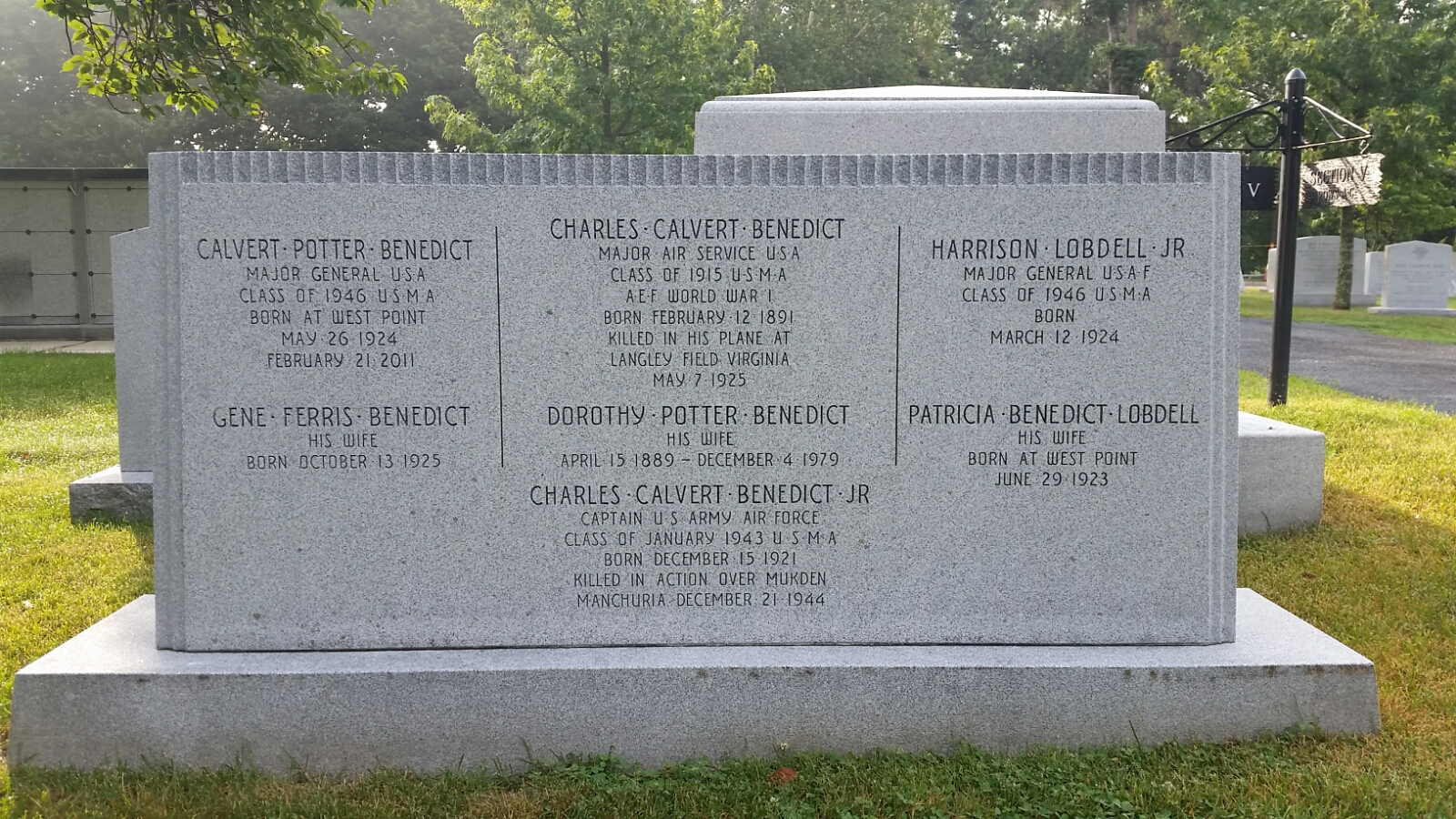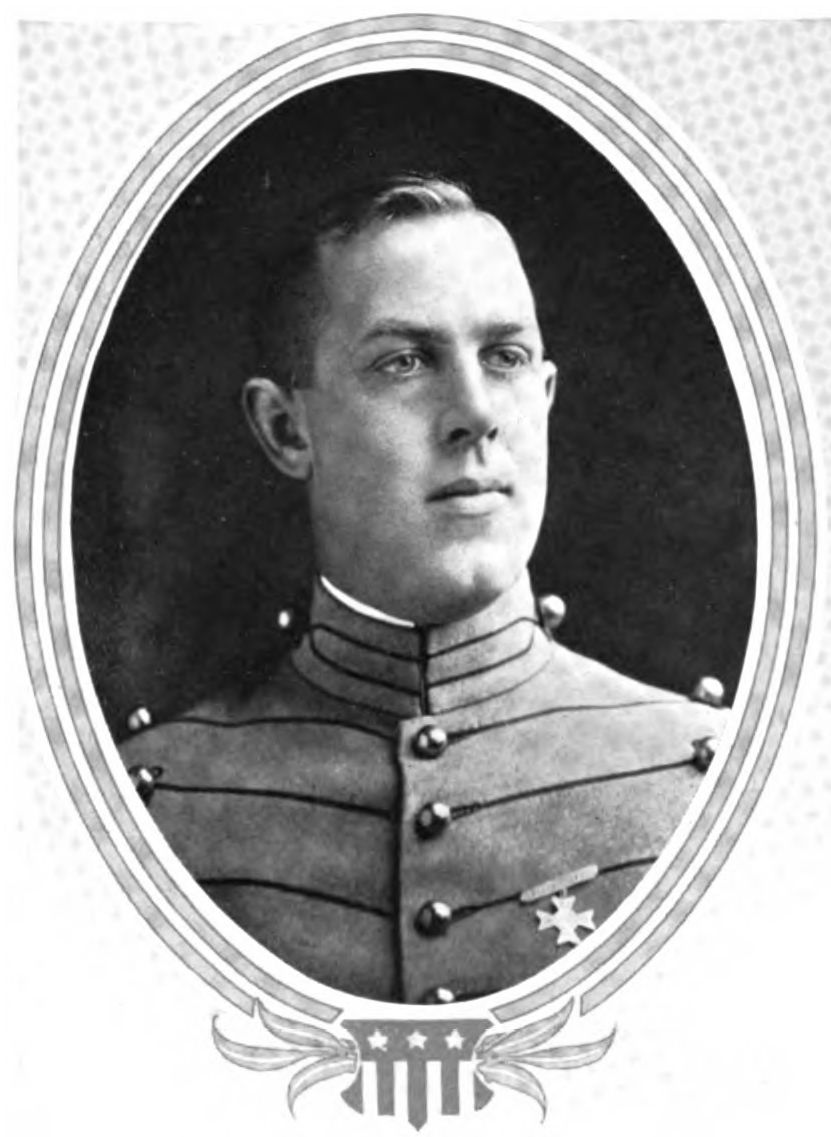Fifty-eighth Annual Report of the Association of Graduates of the United States Military Academy At West Point, New York, June 13, 1927, Seeman & Peters, Saginaw, Michigan, 1927.
Charles Calvert Benedict
No. 5366. Class of 1915.
Died, May 7, 1925, at Langley Field, Virginia, Aged 35 years.
Major Benedict received his flying training in the early days of the Air Corps and served with that branch overseas during the Great War, only to meet death in his plane at Langley Field, Virginia, May 7th, 1925, while engaged in the performance of a tactical mission.
Major Benedict was born in Hastings, Nebraska, February 12, 1890 and entered the United States Military Academy in 1911. While at West Point he was an outstanding figure in athletics, especially football and maintained a keen interest in sports to the time of his death. The story is told that during one of the Navy games in which he played (he had the distinction of helping to defeat the Navy three times) the ball was about to be put into play after a scrimmage, when it was noticed that Cadet Benedict had been left unconscious on the field.
Shortly after graduation in 1915, he transferred to the Aviation Section, Signal Corps, as the Air Corps was originally called, finishing his flying training at San Diego in the spring of 1917 and going overseas the following January.
His first command in France was the Cadet Detachment at Saint Maixent. At that time the Aviation Section, Signal Corps, was undergoing a tremendous expansion. Cadets in all stages of flying training, some not trained at all, were pouring into France and being assembled at Saint Maixent for assignment to various stations. It was the ability he displayed in the difficult task of handling these young men, so lately come from civil life to a foreign land, to war and the hazards and disappointments of training, that resulted in his being ordered to the Third Aviation Instruction Center at Issondum, where similar conditions prevailed. During his station at this, the largest pilot school in the American Expeditionary Force, he was first in command of the Headquarters Detachment and later in charge of flying.
In August 1918, when the American Expeditionary Force was preparing for the Argonne offensive, Major Benedict received orders for the Zone of Advance. He had hoped to have command of a squadron at the front, but was sent instead to the Second Corps Aero School at Chatillon-sur-Seine, as Director and in November, promoted to the grade of Lieutenant Colonel.
Following the armistice he held successively the posts of commanding officer, Trier Airdrome, Germany; Air Service Commander, Third Corps and Air Service Commander, Seventh Corps. The latter command took him to Neuwied, Germany, from which station he returned to the United States in August 1919.
After a few weeks temporary duty in Washington he entered the Air Corps Engineering School, which had just been inaugurated at Dayton, Ohio, taking with him his bride, Miss Dorothy Potter of Chicago. Following graduation a year later he remained on duty with the Engineering Division at McCook (now Wright) Field until February 1922, when he proceeded to London as Assistant Military Attaché for aviation.
During his tour at McCook Field he narrowly escaped death while making a practice parachute jump. Owing to the spinning of his body as he leaped from the wing of the plane, the shroud lines of the chute became twisted and it failed to open. Noting that he was falling faster than another officer who had jumped simultaneously from the opposite wing of the plane, he looked up at his chute and was able to open it and the reserve chute he wore in time to avert a calamity.
In August 1922, orders took him from London to the United States Military Academy for duty in the Department of Tactics. In addition to his duties as L Company’s tac he lectured on Air Corps subjects and renewed the ever pleasant memories of his football days by assisting on the coaching staff.
It was two years later that orders came assigning Major Benedict to the Air Corps Tactical School at Langley Field, Virginia, where, in the closing days of the school year, after completing many flying missions in various types of aircraft, he met his death while participating in an aerial attack on a captive balloon, falling on the airdrome in sight of his comrades. Air Corps officers, two of whom were classmates, cadets of L Company and a formation of airplanes from Mitchell Field escorted him to his last station.
Major Benedict was a graduate of the Center of Artillery Studies at Trier, Germany, the Air Corps Engineering School and the Air Corps Tactical School. He leaves behind him, besides his children Charles, Patricia and Calvert, the memory of a powerful personality, a nature clean, straightforward and courageous, without a trace of the pettiness that smudges so many of us. He liked or did not like and that was all; a thing was right or wrong and that was all. He never quibbled, compromised or regretted. No doubt he would consider his own premature death as properly in line of duty and neither to be wondered at or grieved over. And yet he loved life. Active, athletic, keen, he would go from his work straight to some exercise, preferably out of doors and return home at the day’s end refreshed and buoyantly happy, bringing to a family who adored him, the best of himself and of life.
D.P.B.
Fifty-eighth Annual Report of the Association of Graduates of the United States Military Academy At West Point, New York, June 13, 1927, Seeman & Peters, Saginaw, Michigan, 1927.
Charles Calvert Benedict
No. 5366. Class of 1915.
Died, May 7, 1925, at Langley Field, Virginia, Aged 35 years.
Major Benedict received his flying training in the early days of the Air Corps and served with that branch overseas during the Great War, only to meet death in his plane at Langley Field, Virginia, May 7th, 1925, while engaged in the performance of a tactical mission.
Major Benedict was born in Hastings, Nebraska, February 12, 1890 and entered the United States Military Academy in 1911. While at West Point he was an outstanding figure in athletics, especially football and maintained a keen interest in sports to the time of his death. The story is told that during one of the Navy games in which he played (he had the distinction of helping to defeat the Navy three times) the ball was about to be put into play after a scrimmage, when it was noticed that Cadet Benedict had been left unconscious on the field.
Shortly after graduation in 1915, he transferred to the Aviation Section, Signal Corps, as the Air Corps was originally called, finishing his flying training at San Diego in the spring of 1917 and going overseas the following January.
His first command in France was the Cadet Detachment at Saint Maixent. At that time the Aviation Section, Signal Corps, was undergoing a tremendous expansion. Cadets in all stages of flying training, some not trained at all, were pouring into France and being assembled at Saint Maixent for assignment to various stations. It was the ability he displayed in the difficult task of handling these young men, so lately come from civil life to a foreign land, to war and the hazards and disappointments of training, that resulted in his being ordered to the Third Aviation Instruction Center at Issondum, where similar conditions prevailed. During his station at this, the largest pilot school in the American Expeditionary Force, he was first in command of the Headquarters Detachment and later in charge of flying.
In August 1918, when the American Expeditionary Force was preparing for the Argonne offensive, Major Benedict received orders for the Zone of Advance. He had hoped to have command of a squadron at the front, but was sent instead to the Second Corps Aero School at Chatillon-sur-Seine, as Director and in November, promoted to the grade of Lieutenant Colonel.
Following the armistice he held successively the posts of commanding officer, Trier Airdrome, Germany; Air Service Commander, Third Corps and Air Service Commander, Seventh Corps. The latter command took him to Neuwied, Germany, from which station he returned to the United States in August 1919.
After a few weeks temporary duty in Washington he entered the Air Corps Engineering School, which had just been inaugurated at Dayton, Ohio, taking with him his bride, Miss Dorothy Potter of Chicago. Following graduation a year later he remained on duty with the Engineering Division at McCook (now Wright) Field until February 1922, when he proceeded to London as Assistant Military Attaché for aviation.
During his tour at McCook Field he narrowly escaped death while making a practice parachute jump. Owing to the spinning of his body as he leaped from the wing of the plane, the shroud lines of the chute became twisted and it failed to open. Noting that he was falling faster than another officer who had jumped simultaneously from the opposite wing of the plane, he looked up at his chute and was able to open it and the reserve chute he wore in time to avert a calamity.
In August 1922, orders took him from London to the United States Military Academy for duty in the Department of Tactics. In addition to his duties as L Company’s tac he lectured on Air Corps subjects and renewed the ever pleasant memories of his football days by assisting on the coaching staff.
It was two years later that orders came assigning Major Benedict to the Air Corps Tactical School at Langley Field, Virginia, where, in the closing days of the school year, after completing many flying missions in various types of aircraft, he met his death while participating in an aerial attack on a captive balloon, falling on the airdrome in sight of his comrades. Air Corps officers, two of whom were classmates, cadets of L Company and a formation of airplanes from Mitchell Field escorted him to his last station.
Major Benedict was a graduate of the Center of Artillery Studies at Trier, Germany, the Air Corps Engineering School and the Air Corps Tactical School. He leaves behind him, besides his children Charles, Patricia and Calvert, the memory of a powerful personality, a nature clean, straightforward and courageous, without a trace of the pettiness that smudges so many of us. He liked or did not like and that was all; a thing was right or wrong and that was all. He never quibbled, compromised or regretted. No doubt he would consider his own premature death as properly in line of duty and neither to be wondered at or grieved over. And yet he loved life. Active, athletic, keen, he would go from his work straight to some exercise, preferably out of doors and return home at the day’s end refreshed and buoyantly happy, bringing to a family who adored him, the best of himself and of life.
D.P.B.
Family Members
Sponsored by Ancestry
Advertisement
Explore more
Sponsored by Ancestry
Advertisement
















